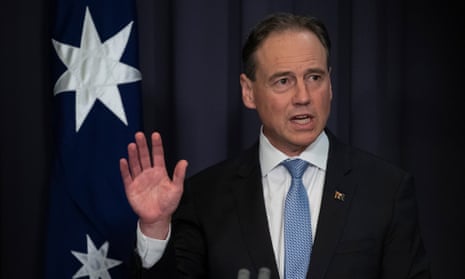Booster vaccines against Covid 19 will be rolled out to the aged care sector within weeks, with the government expecting to offer third shots for all vaccinated Australians by the end of the year.
The announcement comes as Australia reaches the 70% double-dose vaccination rate for those over the age of 16, meeting a key milestone under the national plan whereby the country transitions to phase B and restrictions begin to ease.
The federal health minister, Greg Hunt, said the government was “in advanced consideration” of an application from Pfizer for the use of its booster shots, and he hoped third doses would be rolled out to the aged care sector in the second week of November after a “critical” meeting next week.
“We’re ready, we’re in a position to commence, and to make sure that that additional protection is provided,” Hunt said.
Unlike the initial rollout, the booster program is not expected to target different priority groups, with Hunt saying he expected the key consideration to be the time interval that had passed since a second dose.
“There’s unlikely to be the need to prioritise,” Hunt said.
“The simple thing is time, and because we have sufficient vaccine, we have a system which is capable of delivering, [and] my understanding is every state and territory has spare capacity at this point in time so we want to keep the machine running to keep the program rolling.”
The chief health officer, Professor Paul Kelly, said data from Israel’s booster program was being considered by the government as the Therapeutic Goods Administration and the Australian Technical Advisory Group on Immunisation (Atagi), who would provide advice on the booster program next week.
“It [the Israeli data] very much confirms that this is safe, that it is effective in all age groups, for both decreasing infection, as well as severe disease and then for the older age groups, death and prevention of death,” Kelly said.
The government has not received an application for booster shots from Moderna or AstraZeneca, and Hunt said he did not expect the Australian-made AstraZeneca jab to be used in the booster program.
This will mean people who received the AstraZeneca vaccine will probably receive a Pfizer booster shot.
“Right from the outset, we’ve not envisaged, and the earliest advice was, that AstraZeneca was unlikely to be a booster,” Hunt said.
“Pfizer is in the absolute late stages of its assessment and it’s all progressing very well … if that were available as a universal booster, then it could apply no matter whether you’ve had AstraZeneca or Moderna.”
Hunt said that a third shot of AstraZeneca could be provided to the immunocompromised, and the medical advice for the booster program was still being finalised by Atagi and the TGA.
The health minister also heralded Australia’s climbing vaccination rate, which ticked passed the 70% double-dose rate on Wednesday.
Australia’s first-dose vaccination rate is now at 85.5% nationally, with the double-dose rate at 70.01%. More than 33m doses have been delivered.
“This is a testament to the work of Australians, and it’s a testament to our health professionals and everybody that has been involved in the vaccination program in Australia, so I want to say thank you and congratulations – but keep going,” Hunt said.
While the national figure now sits at more than 70% vaccinated, the coverage across the states remains patchy.
Regional areas are lagging, and Western Australia, Tasmania, Queensland and South Australia are behind Victoria, the ACT and New South Wales that have been grappling with Covid outbreaks.
Hunt said the 70% milestone “represents the movement at a national level to phase B of our national roadmap, but above all else, it represents protection for Australians.”
